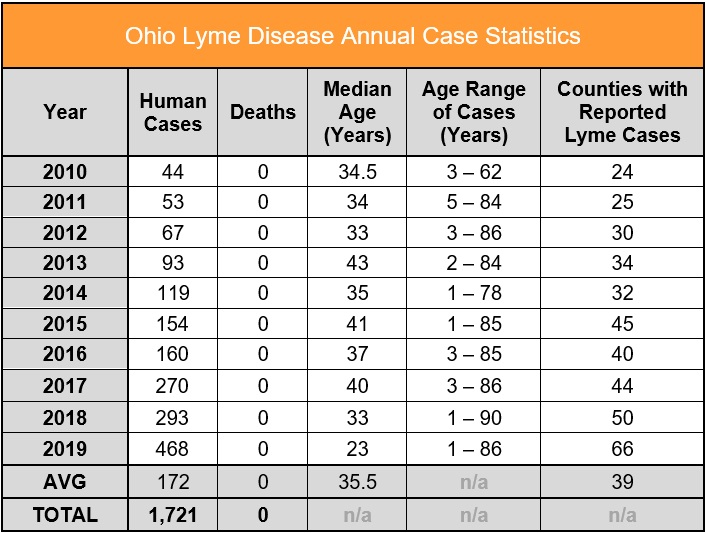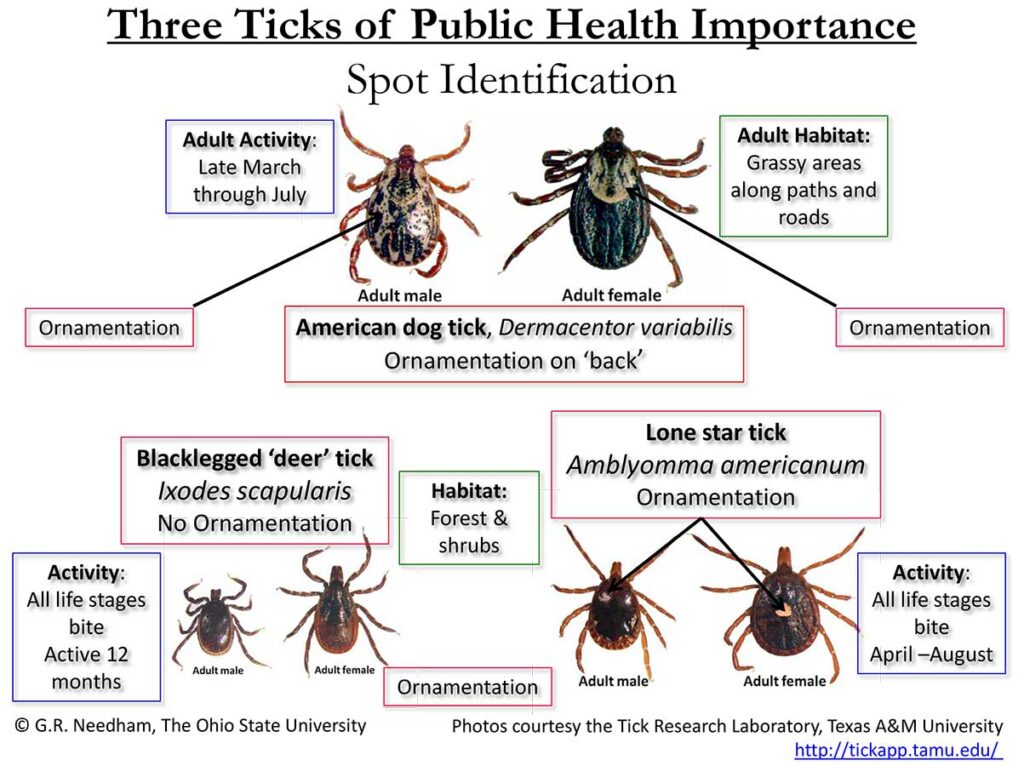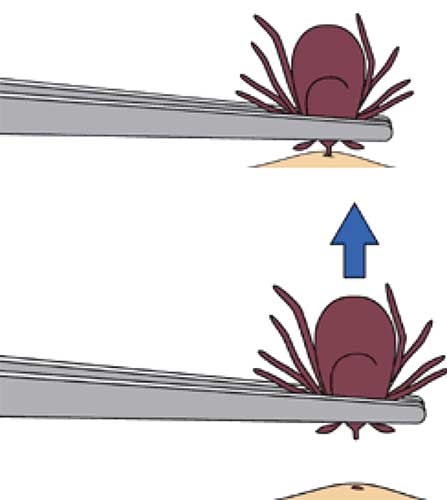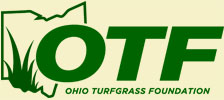Local Northeast Ohio residents are reporting an unprecedented number of ticks this season and there are many reasons why we should all use extra precautions while enjoying the great outdoors this year. According to the Ohio Department of Health, research is showing increasing numbers of ticks and Lyme disease in Portage Turf Specialist’s service areas. Just take a look at the recent results below:

Two unusually warm winters in a row have allowed insect and rodent populations to grow and that includes the Blacklegged Deer Tick and the Brown American Dog Tick; which happen to carry dangerous diseases. Here’s what your Ohio Department of Health has to say:
“Tick-borne diseases can be transmitted only by the bite of an infected tick. An infected animal or person cannot pass the infection on to another animal or person. Ticks normally become infected by taking a blood meal from an infected animal. Use caution when removing ticks from pets and be sure to check yourself and loved ones after spending time in ticks’ habitat.
Ohio has seen a significant increase in the black-legged tick populations in recent years. Blacklegged ticks, also known as deer ticks, are the only known vector of Lyme disease in the eastern U.S. Deer ticks are somewhat smaller and darker than our other important tick species and the adults are active during the late fall – early spring when the other species are dormant.
Rocky Mountain spotted fever (RMSF) is caused by bacteria carried primarily by the American dog tick. Not all ticks are infected and an infected tick is usually attached to the host for four to six hours before it transmits the disease. Adult American dog ticks look for large hosts such as dogs, but they will also feed on humans. They are the most common ticks in Ohio.” (https://www.odh.ohio.gov/odhprograms/bid/zdp/animals/ticks.aspx)
Check out this identification guide to spot a potential carrier:

The Center for Disease Control and Prevention also has updated research and valuable information for the public including this brief summary of important information about the disease.
“Lyme disease is caused by the bacterium Borrelia burgdorferi and is transmitted to humans through the bite of infected black-legged ticks. Typical symptoms include fever, headache, fatigue, and a characteristic skin rash called erythema migrans. If left untreated, the infection can spread to joints, the heart, and the nervous system. Lyme disease is diagnosed based on symptoms, physical findings (e.g., rash), and the possibility of exposure to infected ticks. Laboratory testing is helpful if used correctly and performed with validated methods. Most cases of Lyme disease can be treated successfully with a few weeks of antibiotics. Steps to prevent Lyme disease include using insect repellent, removing ticks promptly, applying pesticides, and reducing tick habitat. The ticks that transmit Lyme disease can occasionally transmit other tickborne diseases as well.” (https://www.cdc.gov/lyme/)
There are lots of ways to protect ourselves, our kids, and our pets from tick bites. When taking these precautions we can all enjoy the outdoors with little fear of ticks.
- Use insect repellent with 20 to 30% DEET on exposed skin and clothing. Parent should avoid eyes and mouth while applying spray repellents
- Use clothing and gear treated with permethrin. Pre-treated fabrics can be washed up to 70 times and still repel ticks.
- Bathe or Shower directly after spending time outdoors.
- Conduct a full body tick check in front a full length mirror
- Parents should check their children for ticks under the arms, in and around the ears, inside the belly button, behind the knees, between the legs, around the waist and especially in their hair.
- Tumble clothes in a dryer on high heat for an hour to kill remaining ticks
- Examine gear and pets. Ticks can ride into the home on clothing and pets, then attach to a person later, so carefully examine pets, coats and day packs.
- Check your pets for ticks daily, especially after they spend time outdoors.
- If you find a tick on your dog, remove it right away.
- Ask your veterinarian to conduct a tick check at each exam.
- Talk to your veterinarian about tick-borne diseases in your area.
- Talk with your veterinarian about using tick preventives on your pet
If you find a tick attached to the skin follow these instructions to remove it immediately.

- Use fine-tipped tweezers to grasp the tick as close to the skin’s surface as possible.
- Pull upward with steady, even pressure. Don’t twist or jerk the tick; this can cause the mouth parts to break off and remain in the skin. If this happens, remove the mouth parts with tweezers. If you are unable to remove the mouth easily with clean tweezers, leave it alone and let the skin heal.
- After removing the tick, thoroughly clean the bite area and your hands with rubbing alcohol, an iodine scrub or soap and water.
- Dispose of a live tick by submersing it in alcohol, placing it in a sealed bag/container, wrapping it tightly in tape or flushing it down the toilet. Never crush a tick with your fingers.
The Ohio Health Department is making the following suggestions about controlling tick populations in our lawns and landscapes:
- Clear tall grasses and brush around homes and at the edge of lawns.
- Place a 3 foot wide barrier of wood chips or gravel between lawns and wooded areas and around patios and play equipment. This will restrict tick migration into recreational areas.
- Mow the lawn frequently and keep leaves raked.
- Stack wood neatly and in a dry area (discourages rodents that ticks feed on).
- Keep playground equipment, decks and patios away from yard edges and trees and place them in a sunny location, if possible.
- Remove any old furniture, mattresses or trash from the yard that may give ticks a place to hide.
- Apply pesticides outdoors to control ticks. A single springtime application of an acaricide (tick pesticide), such as bifenthrin, can greatly reduce the number of ticks in your yard.
- (https://www.odh.ohio.gov/odhprograms/bid/zdp/animals/ticks.aspx)
Portage Turf Specialists is committing to helping our customers deal with the tick concern this year by offering affordable “Flea and Tick” applications. We offer a 5 step flea and tick program starting at just $30.00 per application for customers already signed up for a lawn care program. Together we can raise awareness and reduce fear in our communities so we can all get out and enjoy the outdoors all season.
Contact us at 330-296-8873 or send us a message on our website portageturf.com





